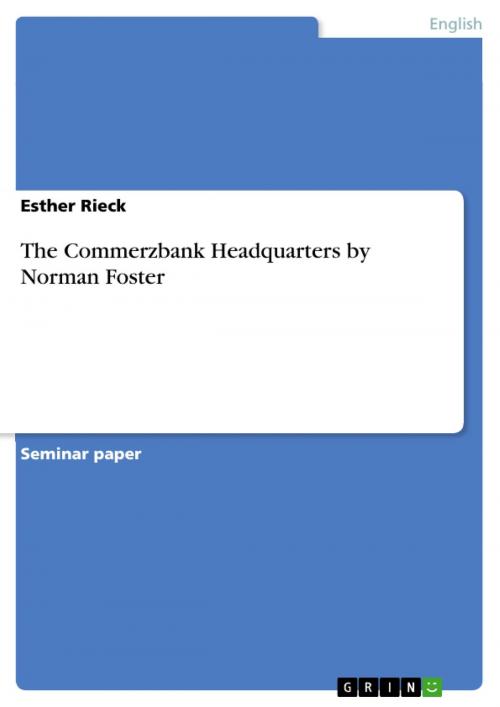The Commerzbank Headquarters by Norman Foster
Nonfiction, Reference & Language, Study Aids, ESL, Foreign Languages| Author: | Esther Rieck | ISBN: | 9783638469128 |
| Publisher: | GRIN Publishing | Publication: | February 13, 2006 |
| Imprint: | GRIN Publishing | Language: | English |
| Author: | Esther Rieck |
| ISBN: | 9783638469128 |
| Publisher: | GRIN Publishing |
| Publication: | February 13, 2006 |
| Imprint: | GRIN Publishing |
| Language: | English |
Seminar paper from the year 2006 in the subject English Language and Literature Studies - Culture and Applied Geography, grade: 2,3, University of Paderborn, course: The Cultural Heritage: The Nineteen Nineties, 8 entries in the bibliography, language: English, abstract: The subject matter of this term paper is a description as well as an interpretation of the 'Commerzbank Headquarters' in Frankfurt which was built by Norman Foster. First I will say a few words about Norman Foster and his works and afterwards about the background of the Commerzbank. In the main part I want to concentrate on the Commerzbank in Frankfurt with its structure and how this 'green' skyscraper works. Norman Foster was born in Manchester in 1935. In 1961 after his final degree at the School of Architecture and City Planning at the University of Manchester, he was given a bursary of the University of Yale where he finished his studies with a master's degree in architecture. In 1963 he formed the 'Team 4', together with his colleague and friend Richard Rogers. Four years later they split off and went separate ways. Foster founded 'Foster Associates' which was later renamed in 'Foster and Partners'. He was knighted in 1990 and appointed to the Order of Merit in 1997. In 1999 he was created a life peer. Foster has received more than 190 awards and citations for his projects and has won over 50 national and international competitions. The Commerzbank Tower, at 300 meters tall, is one of the tallest buildings in Europe and the tallest naturally ventilated building in the world. The German political and social environment played a big role in the development of the design for this building. Frankfurt's 'Green Party' strongly encouraged Commerzbank's new structure to be ,obviously, 'green'. The aim was to create a revolutionary high rise, a high rise that would be both environmentally and people friendly. This building would also have to be a landmark for a town committed to building towers that symbolize hope for a future as a key European financial centre while providing space for about 2600 employees. In order to fulfil these requirements and still create green architecture, Norman Foster had to redesign the concept the skyscraper itself. Some of the ideas which were realized in Frankfurt had their roots in earlier works done by Foster. Back in 1971 he tried to integrate nature into an office building. 'Willis Faber & Dumas' with its roof garden was his first building where he combined a garden with an office building. A few years later the 'Hong Kong and Shanghai Bank' Headquarters was envisioned to have 'gardens in the sky', but this idea was never realized.
Seminar paper from the year 2006 in the subject English Language and Literature Studies - Culture and Applied Geography, grade: 2,3, University of Paderborn, course: The Cultural Heritage: The Nineteen Nineties, 8 entries in the bibliography, language: English, abstract: The subject matter of this term paper is a description as well as an interpretation of the 'Commerzbank Headquarters' in Frankfurt which was built by Norman Foster. First I will say a few words about Norman Foster and his works and afterwards about the background of the Commerzbank. In the main part I want to concentrate on the Commerzbank in Frankfurt with its structure and how this 'green' skyscraper works. Norman Foster was born in Manchester in 1935. In 1961 after his final degree at the School of Architecture and City Planning at the University of Manchester, he was given a bursary of the University of Yale where he finished his studies with a master's degree in architecture. In 1963 he formed the 'Team 4', together with his colleague and friend Richard Rogers. Four years later they split off and went separate ways. Foster founded 'Foster Associates' which was later renamed in 'Foster and Partners'. He was knighted in 1990 and appointed to the Order of Merit in 1997. In 1999 he was created a life peer. Foster has received more than 190 awards and citations for his projects and has won over 50 national and international competitions. The Commerzbank Tower, at 300 meters tall, is one of the tallest buildings in Europe and the tallest naturally ventilated building in the world. The German political and social environment played a big role in the development of the design for this building. Frankfurt's 'Green Party' strongly encouraged Commerzbank's new structure to be ,obviously, 'green'. The aim was to create a revolutionary high rise, a high rise that would be both environmentally and people friendly. This building would also have to be a landmark for a town committed to building towers that symbolize hope for a future as a key European financial centre while providing space for about 2600 employees. In order to fulfil these requirements and still create green architecture, Norman Foster had to redesign the concept the skyscraper itself. Some of the ideas which were realized in Frankfurt had their roots in earlier works done by Foster. Back in 1971 he tried to integrate nature into an office building. 'Willis Faber & Dumas' with its roof garden was his first building where he combined a garden with an office building. A few years later the 'Hong Kong and Shanghai Bank' Headquarters was envisioned to have 'gardens in the sky', but this idea was never realized.















